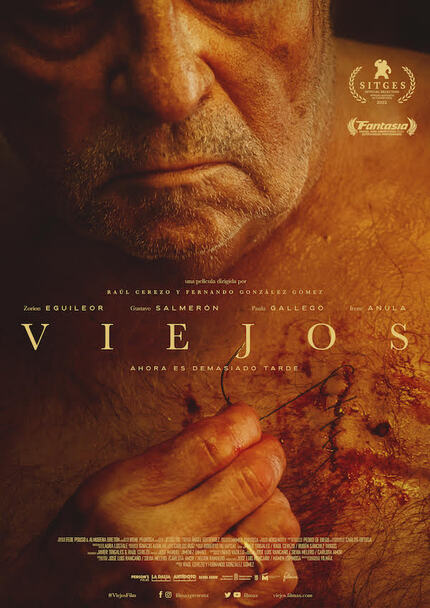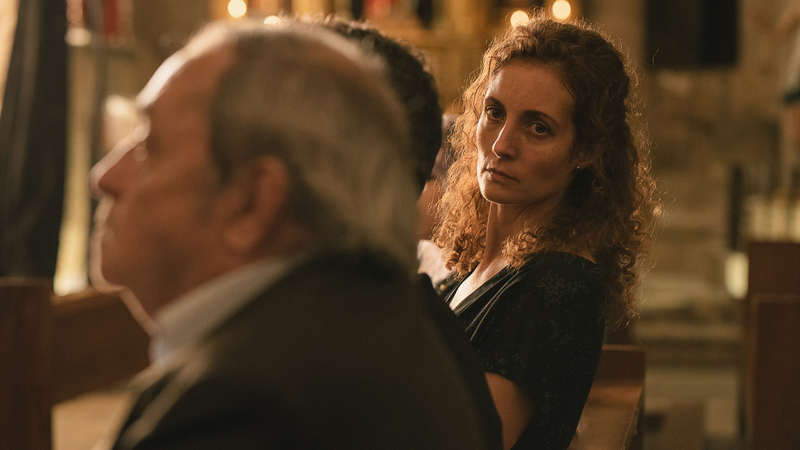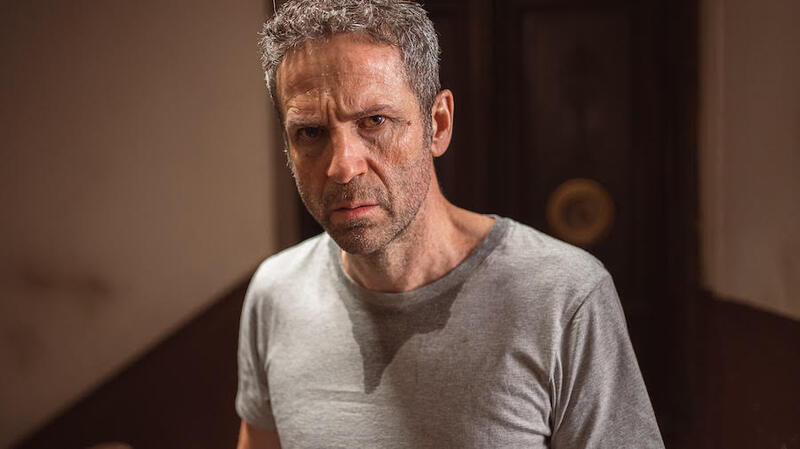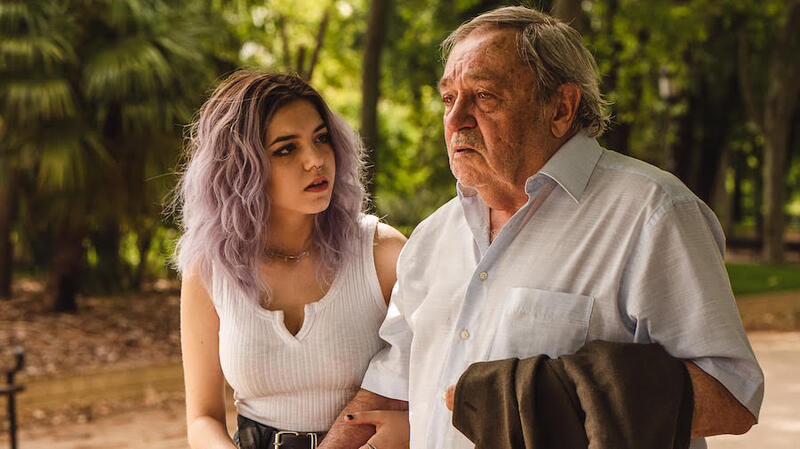Fantasia 2022 Review: THE ELDERLY (VIEJOS), Who do They Turn to When No One at Home is Listening?

Manuel’s world comes to a sudden, screeching halt when his wife, Rosa, jumps from the balcony of their apartment building, killing herself. Beset by grief his son, Mario, insists that Manuel come and stay with him and his family, his Daughter Naia and his second wife, Lena.
There is existing tension in this home. Mario is an a/c technician with no work at the height of summer. Even with temperatures steadily getting worse and worse he has had no work for months. Lena is pregnant and just beginning her leave from a good job (considering her nice clothes and golden name tag she’s wearing at the cremation). Naia, youthfully empathetic towards her grandfather, is possibly more attuned to what’s going on with her grandfather than anyone else. They’ve had to sell their home and move into an apartment given to them by Lena’s parents. Mario suggests that Manuel stay in the room that was going to be the new baby’s room.
Things are going great.
As the temperature steadily climbs the family dynamic becomes further tested and fractured. Manuel is not settling well into his new surroundings and is becoming rather hostile about it. It all comes to a head when he makes a frightening declaration to the family at dinner one night: he is going to kill them all tomorrow.
The Elderly (Viejos), the second feature film from Raúl Cerezo and Fernando González Gómez, the duo of Spanish directors who brought us the goopy sci-fi horror flick The Passenger (La pasajera) last year, is a mysteriously wicked horror that starts off as a tale of supernatural residency and influence on our grandparents. Hold on though, because Cerezo and Gómez have more in store for you - truly unexpected things.
From the… impact… of the prologue we find ourselves at the funeral scene, opening with a scripture reading. The selection of scripture talks about death being defeated with the return of Jesus. Is this the inevitable death that our elderly face? Is someone going to save them from this inevitability? This leads us into our first solid jump scare scene. While there is not an overabundance of these the ones that do happen are gosh, darned effective. They do not overstay their welcome thus they are more effective.
Parts of this act appear to have drawn inspiration from Southeast Asian horror films, that trope of the ever present spirit after death. Abuela still exists in the background, in a passing window or a mirror. The directors also throw in a Tsukamoto Shinya body horror moment later in their movie for good measure, in case there was any doubt of the region’s influence on the filmmakers.
Cerezo and Gómez drop little hints in the prologue, before the title sequence, the change of color in a radio’s frequency node, a circuit board sits on a nightstand. After the funeral Mario goes back to Manuel’s apartment to clean the place up, to convince Lena that Manuel has his whits about him. While he walks through the apartment he looks at a calendar and all the months after have been torn out. Why don’t future dates matter, Manuel? It is a fun puzzle to try to solve as the story unfolds.
We find it very interesting that it is only half way through the film before we learn that Abuelo’s nombre es Manuel. Is this to emphasize how unimportant it was for people to know this? That the elderly are nameless, and a much ignored generation of geriatrics. But, someone is speaking to them and the elderly are listening. And preparing.
You are reminded, how does one fall in with the bad crowd? They’re accepted, listened to, and merely acknowledged. It is enough for them that after they want to be a part of whatever it is that the bad crowd is offering or telling them to do to those that you would think love them and each other. So, stranger and stranger occurrences happen. Manuel becomes more hostile towards Lena and Mario is either inept or trying so hard to reacquaint himself with his father that he is blind to what is going on.
Naia seems to be the only one who treats her Abuelo with love, the pure love of the grandchild who doesn’t have to do anything but love their grandparents. Her love is not shaped by the weight of caring for an aging parent, or the decisions of managing more than one life.
Speaking with the directors about their second film together we found out that in their effort to make their horror flick as “Spanish” as possible the filmmakers drew influence from Spanish artist, Francisco Goya. The title sequence starts what appears to be an foreign, almost alien, landscape but as the image pulls away we see that it is one of Goya’s dark paintings, Two Old Men Eating Soup. It is hugely relevant as with a painting like this Goya was demonstrating the false weaknesses of the old men, who once they were united could face us.
Further to this, when stylizing their film, they referred to the Italian painter, Caravaggio. Together with their cinematographer Ignacio Aguilar they bathed their scenes in a similar lighting scheme, of sharp contrast to a dark background, increasing the level and intensity of oranges and yellows as the heat rises.
We think their command of the cameras is nice, employing a handful of dutch angles and some quick tilts at the end of transitions and scene changes. It is not overly stylized, so much as to lose the plot and the growing threat inside the home. The score by Eneko Vadillo interchanges the thrums and drones of sonic ambience with moaning strings, a couple octaves lower than traditional horror strings usually play.
In regards to acting attention must be made to two actors at both ends of the spectrum. Starting with the youngest actor, Paula Gallego. It took a moment but we remembered where we had seen them before, in their feature film debut, La pasajera (The Passenger), the first collaboration between Cerezo and Gómez. In The Elderly the duo aim for a character on a different part of the personality spectrum than Gallego’s role in their first film.
While her Marta in La pasajera appeared more wholesome she had a massive chip on her shoulder. In The Elderly she may look like she’ll slash your tires as soon as you look at her funny but she lives with more compassion, especially towards her abuelo, acting the role of the sympathetic heart in this horror film. Cerero and Gomez are doing their part to give Gallego proper exposure to the local genre scene. Let's get her in on some more horror flicks, maybe ensemble work as one of many pretty young things destined for the chopping floor, or more small cast work.
At the opposite end you have Zorion Eguileor as Manuel. Eguileor has to be all parts lost, fragile, and vulnerable while being asked at the flip of a switch to become menacing and threatening, angry and belligerent. We think we were expecting a touch more antagonizing and action from Manuel throughout the film. However, when your presence alone is enough to set someone off then conserve your energy for the endgame.
What an endgame it was. All hell breaks loose for a breathtaking 15 minute finale with a closing shot that left us cackling with unbridled enthusiasm. Karyn Kusama's The Invitation immediately came to mind. It's not the same but it was reminiscant of that same level of surprise right at the very end. It is very much in the same spirit of the moment.
In the end the mystery of Manuel's growing hostility may not have been just a loss of agency and independance but guided by a more sinister influence.

Do you feel this content is inappropriate or infringes upon your rights? Click here to report it, or see our DMCA policy.









